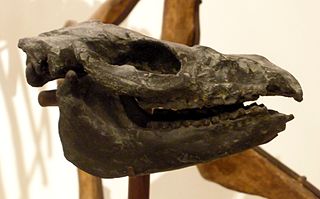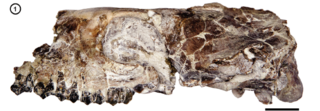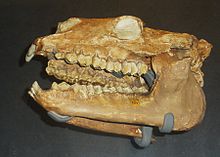
Litopterna is an extinct order of fossil hoofed mammals from the Cenozoic era. The order is one of the five great orders of South American ungulates that were endemic to the continent, until the Great American Biotic Interchange brought new ungulate species. Like other endemic South American mammals, their relationship to other mammal groups had long been unclear, but recent genetic and proteomic evidence indicates that their closest living relatives are Perissodactyls including horses, rhinoceros, and tapirs, and that litopterns are closely related to notoungulates, another widespread group of South American ungulates.

Proterotheriidae is an extinct family of fossil ungulates from the Cenozoic era that displays toe reduction. Despite resembling primitive, small horses, they were only distantly related to them, and instead belonged to the native South American ungulate order Litopterna.
Diplasiotherium is an extinct genus of litoptern belonging to the family Proterotheriidae, that lived between the late Miocene and the early Pliocene. The fossils of this animal have been found in Argentina, in the Monte Hermoso Formation.
Proterotherium is an extinct genus of litoptern mammal of the family Proterotheriidae that lived during the Late Miocene of Argentina and Chile. Fossils of this genus have been found in the Ituzaingó Formation of Argentina, and the Galera Formation of Chile.
Megadolodus is an extinct genus of proterotheriid litopterns.
Deuterotherium is an extinct genus of South American native ungulates, which lived during the Deseadan age of the Oligocene in what is now Argentina. Its type species is Deuterotherium distichum. It was named by Florentino Ameghino in 1895. The holotype of Deuterotherium distichum is a calcaneum. It was formerly identified as a proterotheriid litoptern. In 1999, Shockey argued Deuterotherium was certainly not a litoptern and interpreted it as a notohippid notoungulate. In research by Soria posthumously published in 2001, Soria considered Deuterotherium a nomen dubium.
Olisanophus is a genus of extinct litoptern from the late middle Miocene of southern Bolivia. It was named in 2020 by Andrew McGrath and colleagues, for two distinct species from the same deposits of an unnamed formation of the Honda Group. The type species is O. riorosarioensis, known from elements of the partial upper and lower left and right dentitions and possibly a partial mandible, and the referred species is O. akilachuta, known for 6 teeth. Some intermediate material from the same deposits was referred to Olisanophus sp., not showing diagnostic features of either species. Both species were recovered together in a phylogenetic analysis, where they were sister taxa to a group of Diplasiotherium and Mesolicaphrium.
Mesolicaphrium is a genus of extinct litoptern from the late middle Miocene of southern Colombia. It was named in 2020 by Andrew McGrath and colleagues, for the species previously classified as Prolicaphrium sanalfonensis from the La Victoria and Villavieja Formations of the Honda Group, Colombia. The type species is M. sanalfonense, known from the jaw symphysis and two right mandibular rami, and teeth. Mesolicaphrium is derived from the similarity to the names Prolicaphrium and Neolicaphrium, and being in between both taxa in age. The taxon was recovered in a phylogenetic analysis as the sister taxon of Diplasiotherium, closely related to Olisanophus.
Neodolodus is a genus of extinct litoptern from the late middle Miocene of southern Bolivia. It was named in 1986 by Hoffstetter and Soria, for the species Neodolodus colombianus from the Castilletes Formation and the La Victoria and Villavieja Formations of the Honda Group. The type species N. colombianus is known from a right mandibular ramus, teeth, and part of the fore- and hindlimbs. Neodolodus has been classified as a species of Prothoatherium or Lambdaconus, but was recognized as a distinct genus by McGrath and colleagues in 2020. The taxon was recovered in a phylogenetic analysis as the sister taxon of Protheosodon, between other proterotheriid genera like Picturotherium and Anisolophus.
Picturotherium is a genus of extinct proterotheriid from the middle Miocene of Santa Cruz, Argentina. The genus is known from the type and only species P. migueli, named in 2005 by Alejandro Kramarz and Mariano Bond for individual teeth from the Pinturas Formation. Picturotherium is derived from the Latin for the Rio Pinturas and the word "beast", with the species name honouring South American paleontologist Miguel Soria.
Uruguayodon is an extinct genus of proterotheriid from the middle Pleistocene of Uruguay. It is known from the type and only species U. alius, named by Corona and colleagues in 2019 for dentaries and a partial postcrania from the Raigón Formation. Uruguayodon represents one of the latest occurrences of Proterotheriidae, with only Neolicaphrium representing other remains from the Pleistocene to possibly Holocene.
Brachytherium is an extinct genus of proterotheriid mammal from the Late Miocene to Late Pliocene of Argentina. It is represented by the type and only species B. cuspidatum, a taxon named in 1883 by Ameghino for a partial mandible with teeth. Though it was considered a dubious taxon at times, Brachytherium was revised as valid by Schmidt in 2015, who also synonymized the species Proterotherium gradatum and Lophogonodon paranensis, expanding the material known, all of which is from the Ituzaingó Formation. Some material previously referred to Brachytherium has been given the new name Neobrachytherium.
Neobrachytherium is an extinct genus of proterotheriid mammal from the Late Miocene of Argentina and Uruguay. It is represented by multiple species, including the type N. intermedium, originally named in 1891 by Moreno and Mercerat as a species of Licaphrium, N. morenoi, originally named in 1914 by Rovereto as a species of Brachytherium, and N. ameghinoi and N. ullumense, named in 2001 by Soria, who reclassified all the species in the new genus Neobrachytherium. The various species are known from cranial and dental material from the Corral Quemado, Loma de las Tapias and Ituzaingó Formations. Neobrachytherium may be closely related to Thoatherium, Diadiaphorus and Thoatheriopsis.

Protheosodon is an extinct genus of proterotheriid litoptern. It lived from the Late Oligocene to the Early Miocene in what is now Argentina and Colombia.
Pseudobrachytherium is an extinct genus of proterotheriid from the Late Miocene of Uruguay. It is only known from the type species P. breve, named in 2020 by Corona and colleagues for an almost complete skull found in the greenish pelite of the San Pedro member of the Camacho Formation, which is Huayquerian in age. The genus name is derived from the similarity to the proterotheriid Brachytherium at first glance, with the species name from the Latin for "short", referencing the short groove on the rear of the second molars.

Tetramerorhinus is an extinct genus of proterotheriid litoptern. It lived during the Early Miocene in what is now Argentina and Peru.
Anisolophus is an extinct genus of proterotheriid from the Early to Middle Miocene of Argentina. The genus was named by Burmeister in 1885 to accommodate the species Anchitherium australe, which they had named earlier in 1879. Soria then referred the species Licaphrium floweri and Anisolophus minisculus to the genus, making Licaphrium, named in 1887 by Florentino Ameghino, a junior synonym of the genus. Both A. australis and A. floweri are known from the Santacrucian age Santa Cruz Formation, while A. minisculus is known from the Collón Curá Formation.
Eoauchenia is a genus of extinct proterotheriid from the Late Miocene and Early Pliocene of Argentina. The genus was named by Ameghino in 1887 for the type species E. primitiva, which was originally known from the early Pliocene Monte Hermoso Formation of the Montehermosan age of Buenos Aires Province, but has since been found in the Cerro Azul Formation of the late Huayquerian of La Pampa Province. The fossils originally known included postcranial remains like foot material, but teeth, a skull and skeleton, and mandibles and further postcrania have since been referred to Eoauchenia, which can be distinguished from Epitherium found alongside it by more gracile bones.

Paramacrauchenia is an extinct genus of proterotheriid litopterns from the Early Miocene of what is now Chile. Its fossils have been found in the Santa Cruz Formation of Chile.
Macraucheniopsis is an extinct genus of litoptern mammal belonging to the family Macraucheniidae from the Middle to Late Pleistocene of Argentina. It, along with Macrauchenia, Neolicaphrium, and Xenorhinotherium were among the youngest known genera of litopterns.














